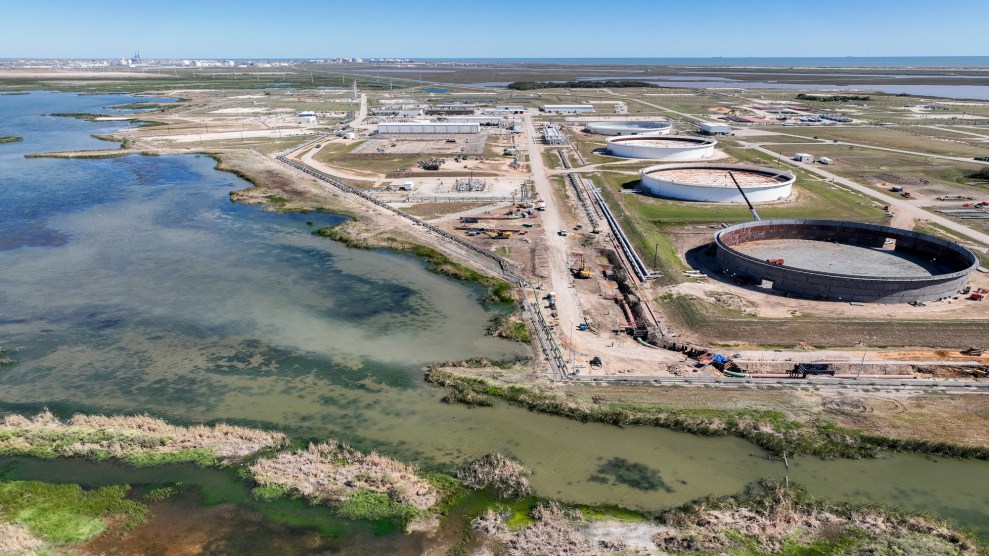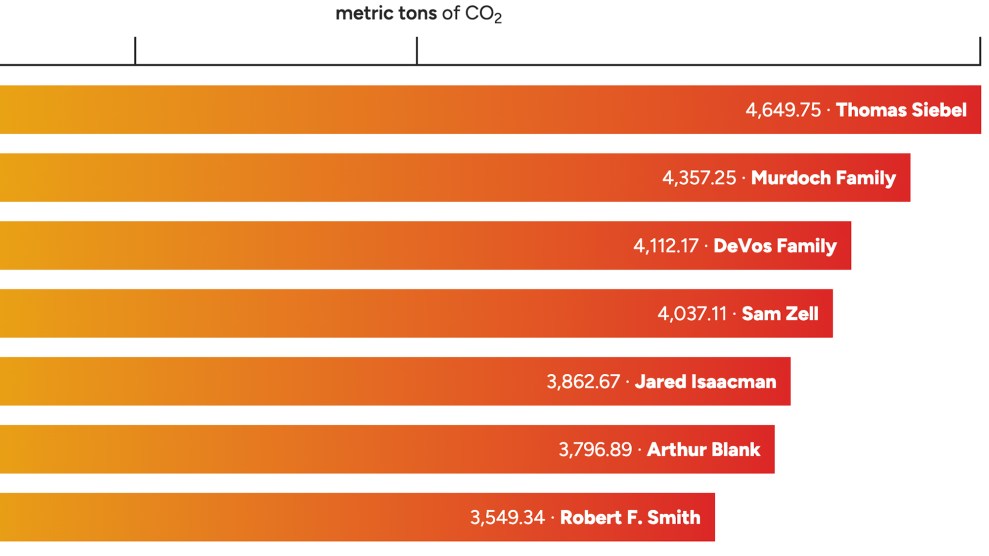
In an aerial view, the Strategic Petroleum Reserve storage at the Bryan Mound site is seen in Freeport, Texas.Brandon Bell/Getty
This story was originally published by the Guardian and is reproduced here as part of the Climate Desk collaboration.
Joe Biden’s administration has been urged not to sink its own climate goals by approving an unprecedented ramp-up of oil export infrastructure off the Texas coast that could result in planet-heating emissions equivalent to three years of the US’s entire emissions output.
The federal government has already quietly approved the Sea Port oil terminal project, a proposed offshore oil platform located 35 miles off the Texas coast, south of Houston, and will decide whether to allow three other nearby oil terminal proposals. Combined, the four terminals would expand US oil exports by nearly 7 million barrels every day, handling the capacity of half of all current national oil exports.
Should all of these projects be allowed to proceed and then operate at full capacity for their expected 30-year lifespan, it will result in an incredible 24 billion metric metric tons of greenhouse gases once the transported oil is burned, an analysis conducted for the Guardian by Global Energy Monitor has found.
These huge “carbon bomb” projects, critics say, fatally undermine Biden’s image as a president who has acted decisively to stem the climate crisis. No new major fossil fuel infrastructure can be built if the world is to avoid dangerous global heating, the International Energy Agency has warned.
“The amount of oil going through these projects, and the resulting emissions, are pretty astounding,” said Baird Langenbrunner, an analyst at Global Energy Monitor, who added that the emissions total is likely a worst-case scenario as it is unlikely all four terminals will be built and then operate at full capacity for decades.
“But even if the emissions are a bit lower then, we are fast-forwarding ourselves to the date where we have to stop completely emitting,” said Langenbrunner. “Any extra emissions are in direct conflict with climate goals and it’s hypocritical for the Biden administration to allow these things to get built and then say the US wants to decrease its own emissions.”
The oil shipped from the planned terminals would be extracted from the vast Permian basin that lies beneath Texas and New Mexico, and fed through a network of pipelines to huge tankers that would convey it from the Gulf of Mexico to buyers overseas. The emissions from the burned oil would not count towards the US’s total carbon pollution, which Biden has vowed to halve this decade, but will still escalate the disastrous climate crisis.
The Sea Port oil terminal, a joint venture between Enterprise, Enbridge and Chevron, will be the US’s largest oil export terminal once built, with a capacity of 2 million barrels a day. This is around a quarter of all the oil the US currently exports each day and is part of a national boom in oil extraction that will hit record levels this year and next, despite Biden’s climate pledges and Republican claims that the US president has shut down domestic drilling.
The project will link 140 miles of land-based and underwater pipelines to an onshore storage facility near the city of Freeport. Two underwater pipelines will run to the deepwater port located offshore, a key requirement for an oil industry that is keen to shift huge amounts of the resource from the Permian basin but has been frustrated by a lack of deep ports on the Texas coast with the capacity for the very largest oil tankers.
In November, the maritime administration, an arm of the US Department of Transport, approved the construction of the Sea Port oil terminal, referencing the heightened demand for new oil and gas in Europe following Russia’s invasion of Ukraine. The project “is in the national interest because the project will benefit employment, economic growth, and US energy infrastructure resilience and security,” the agency wrote in its decision. “The port will provide a reliable source of crude oil to US allies in the event of market disruption.”
The EPA also recommended that the Sea Port oil terminal go ahead, albeit with mitigating features to avoid “disproportionate adverse impacts” to low-income people and people of color who will probably bear the brunt of the new development. Brazoria county, which includes Freeport, already fails to meet national clean air standards for ozone, a pollutant linked to a range of respiratory problems.
The approval of the port has triggered a lawsuit from a coalition of green and local groups, which allege the oil terminal will threaten the critically endangered Rice’s whale, expose already overburdened communities of color to toxic air and create emissions equivalent to running 90 coal-fired power plants, a situation they say is “a stain on the Biden administration’s climate and environmental justice record.”
The maritime administration, meanwhile, is poised to decide upon permits for three other proposed terminals – called Texas Gulf Link, Blue Marlin Offshore Port and Bluewater Texas – that are at various stages of development. The Texas GulfLink project is located just a few miles from the Sea Port oil terminal, running through the small town of Jones Creek.
Until 2015, when Congress lifted a ban on crude oil exports, the US barely exported any fossil fuels, but following a glut of shale oil and fracking activity the country is now the world’s third largest oil exporter and the leading exporter of liquified natural gas, or LNG.
At least 16 gas export terminals have been approved or are under construction along the Gulf of Mexico coast, which, along with the new oil activity, has spurred fresh concerns among environmental justice advocates for coastal communities already dealing with toxic air pollution and safety concerns. In June last year, a large LNG export plant in Freeport exploded, due to what regulators say were systemic failures in its operation.
“It’s shocking the number of pipelines we already have and the dangers we face, such as explosions and oil spills, it’s just too much,” said Melanie Oldham, an air quality activist and Freeport resident who said that many of her neighbors suffer asthma and other health conditions from living next to a tangle of polluting facilities.
“We are a low-income community—65 percent of people here are Hispanic and this seems to be where they always want to build oil terminal projects,” she said. “We are a sacrifice zone. It’s a constant worry and we just wonder when it will all stop.”
Oldham was part of a protest in Washington, DC, last year over the proposed oil terminals, which ended with four arrests. She said she is “extremely disappointed” that Biden has overseen a surge in oil drilling, despite promising to shut it down when he was a candidate for president. Biden has repeatedly called for expanded oil drilling to bring down gasoline costs for US drivers and during his recent State of the Union address said: “We’re going to need oil for at least another decade, and beyond that.”
The Biden administration’s continuing embrace of fossil fuel drilling projects, likely including the controversial Willow project in the Alaska Arctic, risks undermining its major triumphs in confronting the climate crisis, such as the passage last year of the Inflation Reduction Act, a $370 billion package to shift the US to clean energy. Biden’s term has been a confounding one for many climate activists.
“These oil terminals will lock us into decades of greenhouse gas emissions and jeopardizes our ability to meet national and international climate goals,” said Kelsey Crane, senior policy advocate at Earthworks, an environmental group. “The Biden administration’s continued fossil fuel expansion contradicts the science on what we need to do to avoid the most catastrophic consequences of climate change. “We can’t invest in clean energy if we’re not phasing out fossil fuels—we need to reinstate the ban on oil exports and think about a managed decline for fossil fuels within this administration.”
A spokesperson for the maritime administration didn’t answer questions on how its approvals fit in with climate goals but said the Sea Port oil terminal will create “a safer, more efficient mechanism for exporting oil.”















